Tectonic Evolution of the Hainan Island, South China: Geochronological and Geochemical Constraints from Late Permian to Early Triassic Basalts
Abstract
1. Introduction
2. Geological Background and Petrography
2.1. Geological Background
2.2. Sampling and Petrography
3. Analytical Methods
3.1. Analysis and Testing of Major, Trace, and Rare Earth Elements
3.2. Geochronological Analysis
3.3. Zircon and Baddeleyite Hf Isotope Analysis
4. Results
4.1. Zircon and Baddeleyite Geochronology
4.2. Zircon and Baddeleyite Hf Isotopes
4.3. Major and Trace Elements
5. Discussion
5.1. Petrogenesis of the Basalts
5.1.1. Group 1 Basalts
5.1.2. Group 2 Basalts
5.2. Tectonic Setting
6. Geological Significance
7. Conclusions
- Hainan Island recorded two different types of basalts. Group 1 basalts formed at ca. 255 Ma and are sub-alkaline basalts. Their εHf(t) values of baddeleyites and zircons were −10.56 to −4.70 and −14.94 to −6.95, respectively. Two samples from Group 2 basalts dated to 241 ± 2 Ma and 240 ± 4 Ma, respectively. They belong to alkaline basalts, and their εHf(t) values were −2.82 to +4.74, with tDM2 of 1186–810 Ma.
- Group 1 basalts were derived from enriched mantle, likely from partial melting of the spinel lherzolite mantle, and modified by subduction-derived fluids, with a certain degree of fractional crystallization. They were formed in an island arc tectonic setting. Group 2 basalts originated from depleted mantle and were contaminated by crustal material. They were likely produced by partial melting of the garnet + spinel lherzolite mantle and were metasomatized by subduction-derived fluids. They likely formed in a continental intraplate extensional (or initial rift) tectonic setting.
- The formation of the two groups of basalt is related to the evolution of the Paleo-Tethys. Group 1 basalts revealed that subduction of the Paleo-Tethys oceanic crust lasted at least in the late Permian. Group 2 basalts indicate that the initial rift or intra-plate extensional stage occurred during the Middle Triassic.
Supplementary Materials
Author Contributions
Funding
Data Availability Statement
Acknowledgments
Conflicts of Interest
References
- Metcalfe, I. Permian tectonic framework and palaeogeography of SE Asia. J. Asian Earth Sci. 2002, 20, 551–566. [Google Scholar] [CrossRef]
- Metcalfe, I. Tectonic framework and Phanerozoic evolution of Sundaland. Gondwana Res. 2011, 19, 3–21. [Google Scholar] [CrossRef]
- Metcalfe, I. Gondwana dispersion and Asian accretion: Tectonic and palaeogeographic evolution of eastern Tethys. J. Asian Earth Sci. 2013, 66, 1–33. [Google Scholar] [CrossRef]
- Qian, X.; Feng, Q.L.; Wang, Y.J.; Chonglakmani, C.; Monjai, D. Geochronological and geochemical constraints on the mafic rocks along the Luang Prabang zone: Carboniferous back-arc setting in northwest Laos. Lithos 2016, 245, 60–75. [Google Scholar] [CrossRef]
- Hathaichanok, V.; Keith, C.M.; Sopon, P. The hydrocarbon source potential of Permo-Triassic rocks of the Indochina Block adjacent to the Paleo-Tethys suture in Thailand. J. Asian Earth Sci. 2024, 259, 105915. [Google Scholar]
- Wang, D.; Kang, H.; Chen, Y.L.; Li, D.P.; Hu, X.S.; Yu, T.; Liang, Q.K. Timeframe of eastern Paleo-Tethys closure: Constraint on the Songpan-Ganzi Complex by big data-based multiproxy provenance analysis. Lithos 2024, 466–467, 107457. [Google Scholar] [CrossRef]
- Metcalfe, I. 1996. Gondwanaland dispersion, Asian accretion andevolution of eastern Tethys. Aust. J. Earth Sci. 1996, 43, 605–623. [Google Scholar] [CrossRef]
- Wang, Y.J.; Fan, W.M.; Zhang, G.W.; Zhang, Y.L. Phanerozoic tectonics of the South China Block: Key observations and controversies. Gondwana Res. 2013, 23, 1273–1305. [Google Scholar] [CrossRef]
- Wang, Y.J.; Qian, X.; Cawood, P.A.; Liu, H.C.; Feng, Q.L.; Zhao, G.C.; Zhang, Y.H.; He, H.Y.; Zhang, P.Z. Closure of the East Paleotethyan Ocean and amalgamation of the Eastern Cimmerian and Southeast Asia continental fragments. Earth-Sci. Rev. 2018, 186, 195–230. [Google Scholar] [CrossRef]
- Cui, Y.; Wang, Y.J.; Zhou, R.J.; Wang, Y.; Ubide, T.; Qian, X.; Wang, C.; Wang, X. Spatio-temporal evolution of the Paleo-Tethys in western Yunnan: Insights from mafic rocks in the Lancang tectonic belt. Lithos 2024, 488–489, 107830. [Google Scholar] [CrossRef]
- Qin, Y.; Zhou, Y.; Liu, X.J.; Zhao, Y.S.; Li, Z.L.; Yang, L.Y.; Li, C.; Cai, Y.F. Geochronology and geochemistry of igneous rocks in the Qinfang belt: Implications for spatio-temporal framework of Paleo-Tethys. Lithos 2025, 949–945, 107900. [Google Scholar] [CrossRef]
- Hsu, K.J.; Li, J.L.; Chen, H.H.; Wang, Q.C.; Sun, S.; Şengör, A.M.C. Tectonics of South China: Key to understanding West Pacific geology. Tectonophysics 1990, 183, 9–39. [Google Scholar] [CrossRef]
- Metcalfe, I.; Shergoldl, H.; Li, Z.X. IGCP 321 Gondwana dispersion and Asian accretion: Fieldwork on HainanIsland. Episodes 1993, 16, 443–447. [Google Scholar]
- Li, X.H.; Zhou, H.W.; Chung, S.L.; Ding, S.J.; Liu, Y.; Lee, C.Y.; Ge, W.C.; Zhang, Y.M.; Zhang, R.J. Geochemical and Sm–Nd isotopic characteristics of metabasites from central Hainan Island, South China and their tectonic significance. Isl. Arc 2002, 11, 193–205. [Google Scholar] [CrossRef]
- Zhang, H.C.; Xu, Y.J.; Cawood, P.A.; Zi, J.W.; Zhou, J.B.; Du, Y.S. Linking the Paleozoic evolution of Hainan Island to Indochina and Australia: Implication for the paleogeography of the eastern Tethys Ocean. Tectonophysics 2023, 858, 229882. [Google Scholar] [CrossRef]
- Song, Q.Q.; Hu, J.; Lei, D.; Li, Z.W.; Tang, R.; Hu, S.B. Provenance evolution of the Fushan Sag (Hainan Island, southern China): Constraints from U-Pb geochronology on detrital zircons. Mar. Pet. Geol. 2024, 168, 107037. [Google Scholar] [CrossRef]
- Li, S.B.; He, H.Y.; Qian, X.; Wang, Y.J.; Zhang, A.M. Carboniferous arc setting in Central Hainan: Geochronological and geochemical evidences on the andesitic and dacitic rocks. J. Earth Sci. 2018, 29, 265–279. [Google Scholar] [CrossRef]
- Zhou, Y.; Sun, S.Y.; Feng, Z.H.; Xu, C.; Cai, Y.F.; Liang, X.Q.; Liu, X.J.; Du, Y.J. A new insight into the eastern extension of the Proto-Tethyan margin of Gondwana by Early Paleozoic volcanic rocks in South China. Lithos 2021, 338–339, 106328. [Google Scholar] [CrossRef]
- Li, Z.X.; Li, X.H.; Li, W.X.; Ding, S.I. Was Cathaysia part of Proterozoic Laurentia?—New data from Hainan Island, south China. Terra Nova 2008, 20, 154–164. [Google Scholar] [CrossRef]
- Yao, W.H.; Li, Z.X.; Li, W.X.; Li, X.H. Proterozoic tectonics of Hainan Island in supercontinent cycles: New insights from geochronological and isotopic results. Precambrian Res. 2017, 290, 86–100. [Google Scholar] [CrossRef]
- Wang, X.F.; Ma, D.Q.; Jiang, D.H. Geology of Hainan Island: Structural Geology; Geological Publish House: Beijing, China, 1991. [Google Scholar]
- Cao, G.Y.; Li, X.; Xie, G.G.; Zhang, Z.Y.; Wang, L.; Tong, Y. Petrogenesis of late Permian to Middle Triassic magmatic rocks on northern Hainan Island, South China: Implications for crust-mantle interaction and the tectonic evolution of the Paleo-Tethys. J. Asian Earth Sci. 2002, 234, 105238. [Google Scholar] [CrossRef]
- Xie, C.F.; Zhu, J.C.; Ding, S.J.; Zhang, Y.M.; Fu, T.A.; Li, Z.H. Identification of Hercynian shoshonitic intrusive rocks in central Hainan Island and its geotectonic implications. Chin. Sci. Bull. 2006, 51, 2507–2519. [Google Scholar] [CrossRef]
- Zhou, Y.; Liang, X.Q.; Kröner, A.; Cai, Y.F.; Shao, T.B.; Wen, S.N.; Jiang, Y.; Fu, J.G.; Wang, C.; Dong, C.G. Late Cretaceous lithospheric extension in SE China: Constraints from volcanic rocks in Hainan Island. Lithos 2015, 23, 100–110. [Google Scholar] [CrossRef]
- He, H.Y.; Wang, Y.J.; Qian, X.; Zhang, Y.Z. The Bangxi-Chenxing tectonic zone in Hainan Island (South China) as the eastern extension of the Song Ma-Ailaoshan zone: Evidence of late Paleozoic and Triassic igneous rocks. J. Asian Earth Sci. 2018, 164, 274–291. [Google Scholar] [CrossRef]
- Griffin, W.L.; Wang, X.; Jackson, S.E.; Pearson, N.J.; O’Reilly, S.Y.; Xu, X.S.; Zhou, X.M. Zircon chemistry and magma mixing, SE China: In-situ analysis of Hf isotopes, Tonglu and Pingtan igneous complexes. Lithos 2002, 61, 237–269. [Google Scholar] [CrossRef]
- Wu, F.Y.; Yang, Y.H.; Xie, L.W.; Yang, J.H.; Xu, P. Hf isotopic compositions of the standard zircons and baddeleyites used in u–pb geochronology. Chem. Geol. 2006, 234, 105–126. [Google Scholar] [CrossRef]
- Scherer, E.; Munker, C.; Mezger, K. Calibration of the lutetium-hafnium clock. Science 2001, 293, 683–687. [Google Scholar] [CrossRef]
- Blichert, T.J.; Albarède, F. The Lu-Hf isotope geo-chemistry of chondrites and the evolution of the mantle-crust system. Earth Planet. Sci. Lett. 1997, 148, 243–258. [Google Scholar] [CrossRef]
- Hoskin, P.W.O.; Schaltegger, U. The composition of zircon and igneous and metamorphic petrogenesis. Rev. Mineral. Geochem. 2003, 53, 27–62. [Google Scholar] [CrossRef]
- Rubatto, D. Zircon trace element geochemistry: Partitioning with garnet and the link between U–Pb ages and metamorphism. Chem. Geol. 2002, 184, 123–138. [Google Scholar] [CrossRef]
- Tsygankov, A.A.; Khubanov, V.B.; Burmakina, G.N.; Buyantuev, M.D. Periodicity of Endogenic Events of West Transbaikalia and North Mongolia (Eastern Segment of the Central Asian Foldbelt): U–Pb Age of Detrital Zircon from the Present-Day River Sediments. Stratigr. Geol. Correl. 2023, 31, 355–375. [Google Scholar] [CrossRef]
- Sun, S.S.; McDonough, W.F. Chemical and isotopic systematics of oceanic basalts: Implication for mantle composition and processes. Geol. Soc. Lond. Spec. Publ. 1989, 42, 313–345. [Google Scholar] [CrossRef]
- Qian, X.; Feng, Q.L.; Wang, Y.J.; Zhang, Z.B. Geochemical and Geochronological Constraints on the Origin of the Meta-basic Volcanic Rocks in the Tengtiaohe Zone, Southeast Yunnan. Acta Geol. Sin. (Engl. Ed.) 2016, 90, 669–683. [Google Scholar]
- Zhang, Y.Z.; Yang, X.; Wang, Y.J.; Qian, X.; Wang, Y.K.; Gou, Q.Y.; Senebouttalath, V.; Zhang, A.M. Rifting and subduction records of the Paleo–Tethys in North Laos: Constraints from Late Paleozoic mafic and plagiogranitic magmatism along the Song Ma tectonic zone. Geol. Soc. Am. Bull. 2020, 133, 212–232. [Google Scholar] [CrossRef]
- Wang, Y.J.; Zhang, A.M.; Fan, W.M.; Peng, T.P.; Zhang, F.F.; Zhang, Y.Z.; Bi, X.W. Petrogenesis of late Triassic post-collisional basaltic rocks of the Lancangjiang tectonic zone, southwest China, and tectonic implications for the evolution of the eastern Paleotethys: Geochronological and geochemical constraints. Lithos 2010, 120, 529–546. [Google Scholar] [CrossRef]
- Srichan, W.; Crawford, A.J.; Berry, R.F. Geochemistry and geochronology of Late Triassic volcanic rocks in the Chiang Khong region, northern Thailand. Isl. Arc 2009, 18, 32–51. [Google Scholar] [CrossRef]
- Vervoort, J.D.; Pachelt, P.J.; Albarede, F.; Blichert-Toft, J.; Rudnick, R.; Downes, H. Hf-Nd isotopic evolution of the lower crust. Earth Planet. Sci. Lett. 2000, 181, 115–129. [Google Scholar] [CrossRef]
- Hoffman, A.W.; Jochum, K.P.; Seufert, M.; White, W.M. Nd and Pb in Oceanic Basalts: New Constraints on Mantal Evolution. Earth Planet. Sci. Lett. 1986, 79, 33–45. [Google Scholar] [CrossRef]
- Hoffman, P.F.; Ranalli, G. Archean Ocean flake tectonics. Geophys. Res. Lett. 1998, 15, 1077–1080. [Google Scholar] [CrossRef]
- Boniface, N.; Schenk, V.; Appel, P. Paleoproterozoic eclogites of MORB-type chemistry and three Proterozoic orogenic cycles in the Ubendian Belt (Tanzania): Evidence from monazite and zircon geochronology, and geochemistry. Precambrian Res. 2012, 192–195, 16–33. [Google Scholar] [CrossRef]
- Kay, S.M.; Ramos, V.A.; Marquez, M. Evidence in cerro pampa volcanic rocks for slab-melting prior to ridge-trench collision in Southern South America. J. Geol. 1993, 101, 703–714. [Google Scholar] [CrossRef]
- Pearce, J.A.; and Peate, D.W. Tectonic implications of the composition of volcanic arc magmas. Annu. Rev. Earth Planet. Sci. Lett. 1995, 23, 251–286. [Google Scholar] [CrossRef]
- Xu, Y.G.; Chung, S.L.; Jahn, B.N.; Wu, G. Petrologic and geochemical constraints on the petrogenesis of Permian–Triassic Emeishan flood basalts in southwestern China. Lithos 2001, 58, 145–168. [Google Scholar] [CrossRef]
- Rooney, T.O. Geochemical evidence of lithospheric thinning in the southern Main Ethiopian Rift. Lithos 2010, 117, 33–48. [Google Scholar] [CrossRef]
- Wilson, M. Igneous Petrogenesis: A Global Tectonic Approach; Unwin Hyman: London, UK, 1989; pp. 1–466. [Google Scholar]
- Yoder, H.S. Evolution of the Igneous Rocks; Princeton University Press: Princeton, NJ, USA, 1979. [Google Scholar]
- Stolz, A.J.; Jochum, K.P.; Spettel, B.; Hofmann, A.W. Fluid and melt-related enrichment in the subarc mantle: Evidence from Nb/Ta variations in island-arc basalts. Geology 1996, 24, 587–590. [Google Scholar] [CrossRef]
- Rudnick, R.L.; Fountain, D.M. Nature and composition of the continental crust: A lower crustal perspective. Rev. Geophys. 1995, 33, 267–309. [Google Scholar] [CrossRef]
- Pearce, J.A.; Harris, N.B.W.; Tindle, A.G. Trace element discrimination diagrams for the tectonic interpretation of granitic rocks. J. Petrol. 1984, 25, 956–983. [Google Scholar] [CrossRef]
- Sun, S.Q.; Wang, Y.L.; Zhang, C.J. Discrimination of the tectonic setting of basalts by Th, Nb and Zr. Geol. Rev. 2003, 49, 40–47, (In Chinese with English abstract). [Google Scholar]
- Wang, Y.L.; Zhang, C.J.; Xiu, S.Z. Th/Hf-Ta/Hf identification of tectonic setting of basalts. Acta Petrol. Sin. 2001, 17, 413–421, (In Chinese with English abstract). [Google Scholar]
- Jian, P.; Liu, D.Y.; Sun, X.M. SHRIMP dating of the Permo-Carboniferous Jishajiang ophiolite, southwestern China: Geochronological constraints for the evolution of Paleo-Tethys. J. Asian Earth Sci. 2008, 32, 371–384. [Google Scholar] [CrossRef]
- Jian, P.; Liu, D.Y.; Kröner, A.; Zhang, Q.; Wang, Y.Z.; Sun, X.M.; Zhang, W. Devonian to Permian plate tectonic cycle of the Paleo-Tethys Orogen in southwest China (I): Geochemistry of ophiolites, arc/back-arc assemblages and within-plate igneous rocks. Lithos 2009, 113, 748–766. [Google Scholar] [CrossRef]
- Jian, P.; Liu, D.Y.; Kröner, A.; Zhang, Q.; Wang, Y.Z.; Sun, X.M.; Zhang, W. Devonian to Permian plate tectonic cycle of the Paleo-Tethys Orogen in southwest China (II): Insights from zircon ages of ophiolites, arc/back-arc assemblages and within-plate igneous rocks and generation of the Emeishan CFB province. Lithos 2009, 113, 767–784. [Google Scholar] [CrossRef]
- Lepvrier, C.; Vuong, N.V.; Maluski, H.; Thi, P.T.; Vu, T.V. Indosinian tectonics in Vietnam. Comptes Rendus—Géosci. 2008, 340, 94–111. [Google Scholar] [CrossRef]
- Wang, X.F.; Metcalfe, I.; Jian, P.; He, L.Q.; Wang, C.S. The Jishajiang-Ailaoshan suture zone, China: Tectonostratigraphy, age and evolution. J. Asian Earth Sci. 2000, 18, 675–690. [Google Scholar] [CrossRef]
- Fan, W.M.; Wang, Y.J.; Zhang, A.M.; Zhang, F.F.; Yuzhi Zhang, Y.Z. Permian arc–back-arc basin development along the Ailaoshan tectonic zone: Geochemical, isotopic and geochronological evidence from the Mojiang volcanic rocks, Southwest China. Lithos 2010, 119, 553–568. [Google Scholar] [CrossRef]
- Liu, H.C.; Wang, Y.J.; Cawood, P.A.; Fan, W.M.; Cai, Y.F.; Xing, X.W. Record of Tethyan ocean closure and Indosinian collision along the Ailaoshan suture zone (SW China). Gondwana Res. 2015, 27, 1292–1306. [Google Scholar] [CrossRef]
- Hu, F.Y.; Wu, F.Y.; Wang, J.G.; Ducea, M.N.; Chapman, J.B.; Zaw, K.; Lin, W.; Sein, K.; Meffre, S. Newly discovered Early Carboniferous and Late Permian magmatic rocks in eastern Myanmar: Implications for the tectonic evolution of the eastern Paleo-Tethys. J. Asian Earth Sci. 2022, 227, 105093. [Google Scholar] [CrossRef]
- Chuan, M.S.; Hu, L.; Lin, R.X.; Mao, C.Z.; Li, S.Z.; Li, S.M.; Yuan, Y.S. Origin and tectonic implications of early Mesozoic “mung bean rock” in the western margin of the Yangtze Platform: Zircon U-Pb age, trace elements and Hf isotope constraints. Earth Sci. Front. 2024, 31, 204–223, (In Chinese with English abstract). [Google Scholar]
- Zi, J.W.; Cawood, P.A.; Fan, W.M.; Tohver, E.; Wang, Y.J.; McCuaig, C.T. Generation of Early Indosinian enriched mantle-derived granitoid pluton in the Sanjiang Orogen (SW China) in response to closure of the Paleo-Tethys. Lithos 2012, 140, 166–182. [Google Scholar] [CrossRef]
- Zhu, J.J.; Hu, R.Z.; Bi, X.W.; Zhong, H.; Chen, H. Zircon U-Pb Ages, Hf-O Isotopes and Whole-Rock Sr-Nd-Pb Isotopic Geochemistry of Granitoids in the Jinshajiang Suture Zone, SW China: Constraints on Petrogenesis and Tectonic Evolution of the Paleo-Tethys Ocean. Lithos 2011, 126, 248–264. [Google Scholar] [CrossRef]
- Qian, X.; Li, H.L.; Yu, X.Q.; Zhang, Y.Z.; Wang, Y.J. Permian-Triassic Magmatism Along the Truong Son Zone in SE Asia and its Paleotethyan Tectonic Implications. Geotecton. Metallog. 2022, 46, 585–604, (In Chinese with English abstract). [Google Scholar]
- Hoa, T.T.; Anh, T.T.; Phuong, N.T.; Dung, P.T.; Anh, T.V.; Izokh, A.E.; Borisenko, A.S.; Lan, C.Y.; Chung, S.L.; Lo, C.H. Permo-Triassic intermediate-felsic magmatism of the Truong Son belt, eastern margin of Indochina. Comptes Rendus Geosci. 2008, 340, 112–126. [Google Scholar] [CrossRef]
- Shi, M.F.; Zhu, H.P.; Lin, F.C.; Fan, W.Y.; Wang, h.; Deng, Q.; Cong, F. Geochemical characteristic, zircon U-Pb age and Hf isotopic compositions of monzogranites from the Thack Khe Iron deposit, Vietnam. Acta Geol. Sin. 2015, 89, 1683–1695, (In Chinese with English abstract). [Google Scholar]
- Halpin, J.A.; Tran, H.T.; Lai, C.K.; Meffre, S.; Zaw, K. U-Pb zircon geochronology and geochemistry from NE Vietnam: A ’tectonically disputed’ territory between the Indochina and South China Blocks. Gondwana Res. 2016, 34, 254–273. [Google Scholar] [CrossRef]
- Huang, C.W.; Li, H.; Lai, C.K. Genesis of the Binh do Pb-Zn deposit in northern Vietnam: Evidence from H-O-S-Pb isotope geochemistry. J. Earth Sci. 2019, 30, 679–688. [Google Scholar] [CrossRef]
- Li, X.H.; Li, Z.X.; Li, W.X.; Wang, Y.J. Initiation of the Indosinian Orogeny in South China: Evidence for a Permian magmatic arc on Hainan Island. J. Geol. 2006, 114, 341–353. [Google Scholar] [CrossRef]
- Xu, D.R.; Xia, B.; Li, P.C.; CHEN, G.H.; MA, C.; ZHANG, Y.Q. Protolith natures and U-Pb sensitive high mass-resolution ion microprobe (SHRIMP) zircon ages of the metabasites in Hainan Island, South China: Implications for geodynamic evolution since the late Precambrian. Isl. Arc 2007, 16, 575–597. [Google Scholar] [CrossRef]
- Yan, Q.S.; Metcalfe, I.; Shi, X.F. U-Pb isotope geochronology and geochemistry of granites from Hainan Island (northern South China Sea margin): Constraints on late Paleozoic-Mesozoic tectonic evolution. Gondwana Res. 2017, 49, 333–349. [Google Scholar] [CrossRef]
- Shen, L.W.; Yu, J.H.; O’Reilly, S.Y.; Griffin, W.L.; Xueyao Zhou, X.Y. Subduction-related middle Permian to early Triassic magmatism in central Hainan Island, South China. Lithos 2018, 318–319, 158–175. [Google Scholar] [CrossRef]
- He, H.Y.; Wang, Y.J.; Zhang, Y.H.; Qian, X.; Zhang, Y.Z. Fingerprints of the Paleotethyan back-arc basin in Central Hainan, South China: Geochronological and geochemical constraints on the Carboniferous metabasites. Int. J. Earth Sci. 2018, 107, 553–570. [Google Scholar] [CrossRef]
- He, H.Y.; Wang, Y.J.; Cawood, P.A.; Qian, X.; Zhang, Y.Z.; Zhao, G.F. Permo–Triassic granitoids, Hainan Island, link to Paleotethyan not Paleopacific tectonics. Geol. Soc. Am. Bull. 2020, 132, 2067–2083. [Google Scholar] [CrossRef]
- Zhou, Y.; Yan, Y.; Liu, H.L.; Cai, J.X.; Zhou, M.F.; Zhang, X.C.; Wang, Y.; Shen, B.Y. U-Pb isotope geochronology of syntectonic granites from Hainan Island, South China: Constraints on tectonic evolution of the eastern Paleo-Tethys Ocean. J. Ocean Univ. China 2020, 19, 1315–1330. [Google Scholar] [CrossRef]
- Ouyang, J.T.; Zhou, Y.; Liu, X.J.; Li, Z.L.; Xie, Y.H.; Cai, Y.F. Petrogenesis of Late Permian granites from West Hainan Island and its geotectonic implications. Chin. J. Geol. 2025, 60, 212–228, (In Chinese with English abstract). [Google Scholar]
- Tang, L.M.; Chen, H.L.; Dong, C.W.; Yang, S.F.; Shen, Z.Y.; Cheng, X.G.; Fu, L.L. Middle Triassic post-orogenic extension on Hainan Island: Chronology and geochemistry constraints of bimodal intrusive rocks. Sci. China Earth Sci. 2013, 56, 783–793. [Google Scholar] [CrossRef]
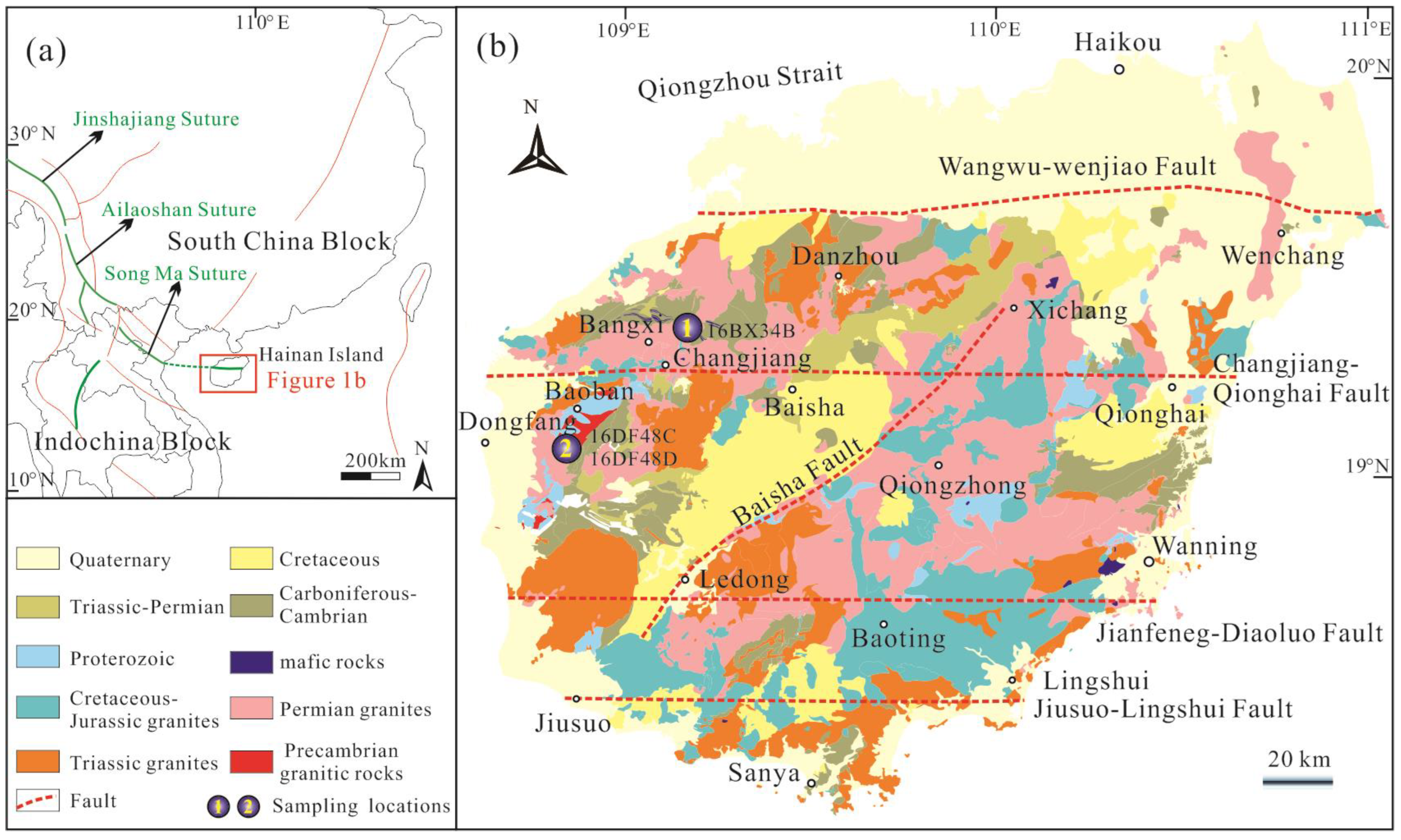
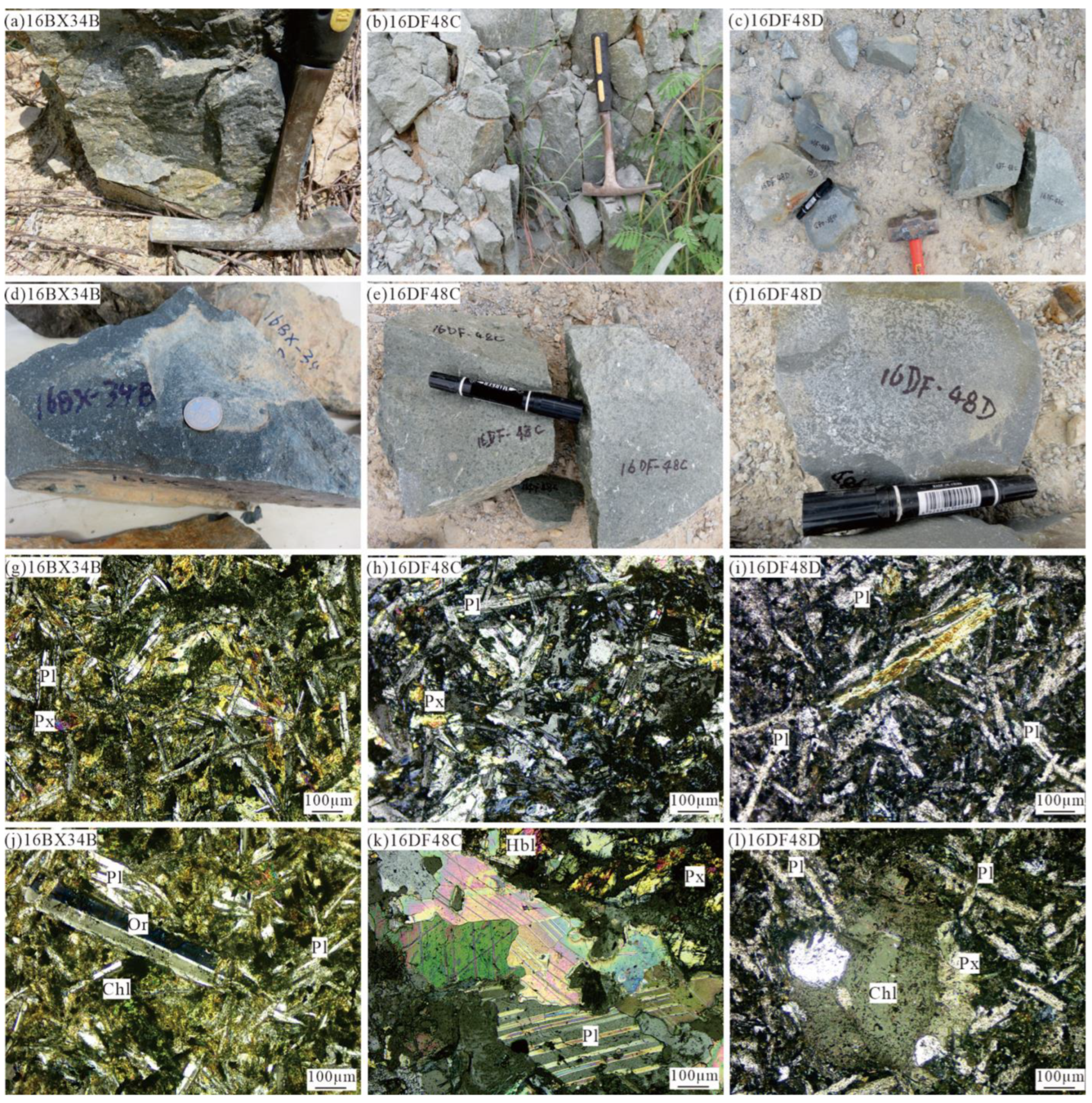
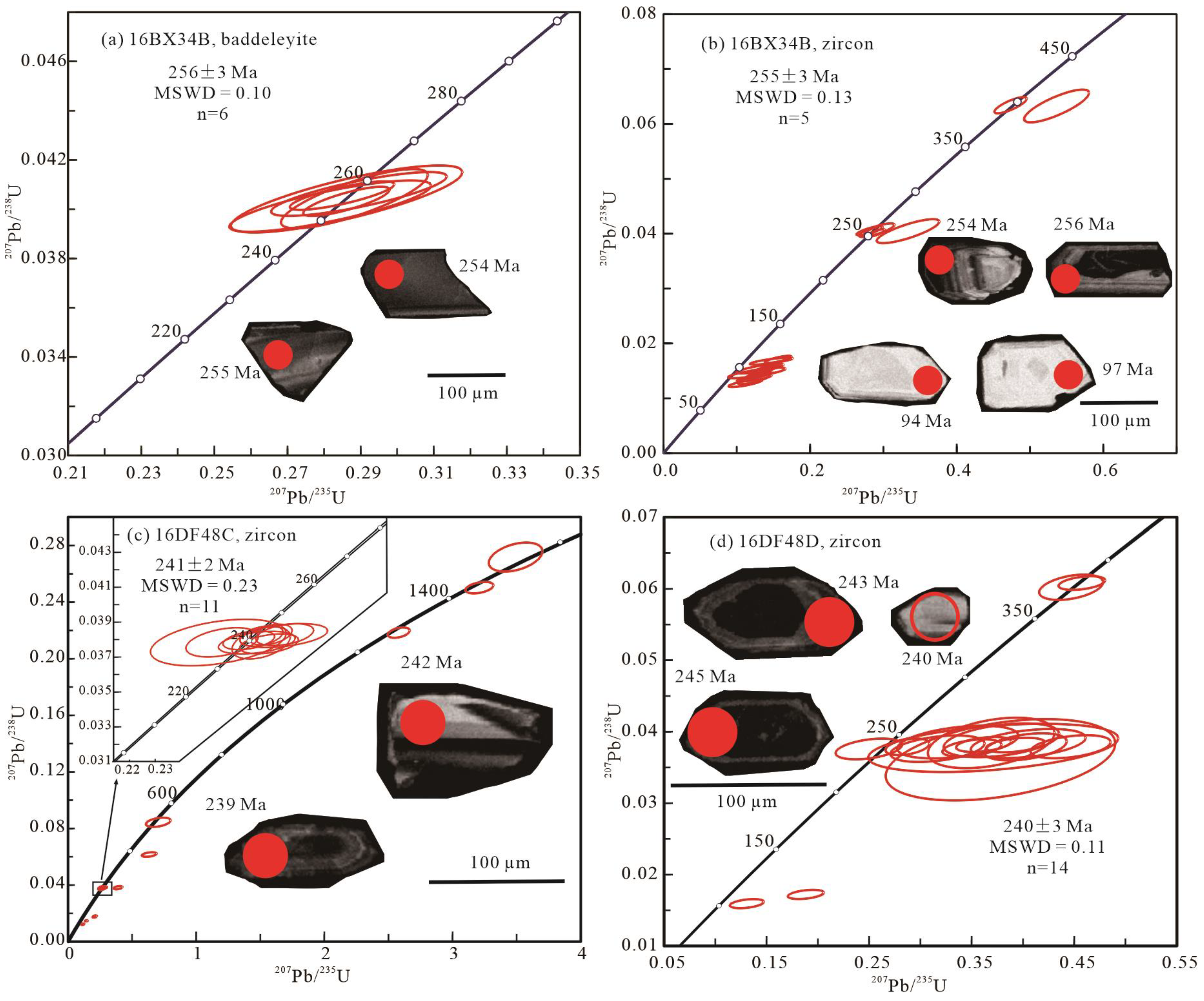
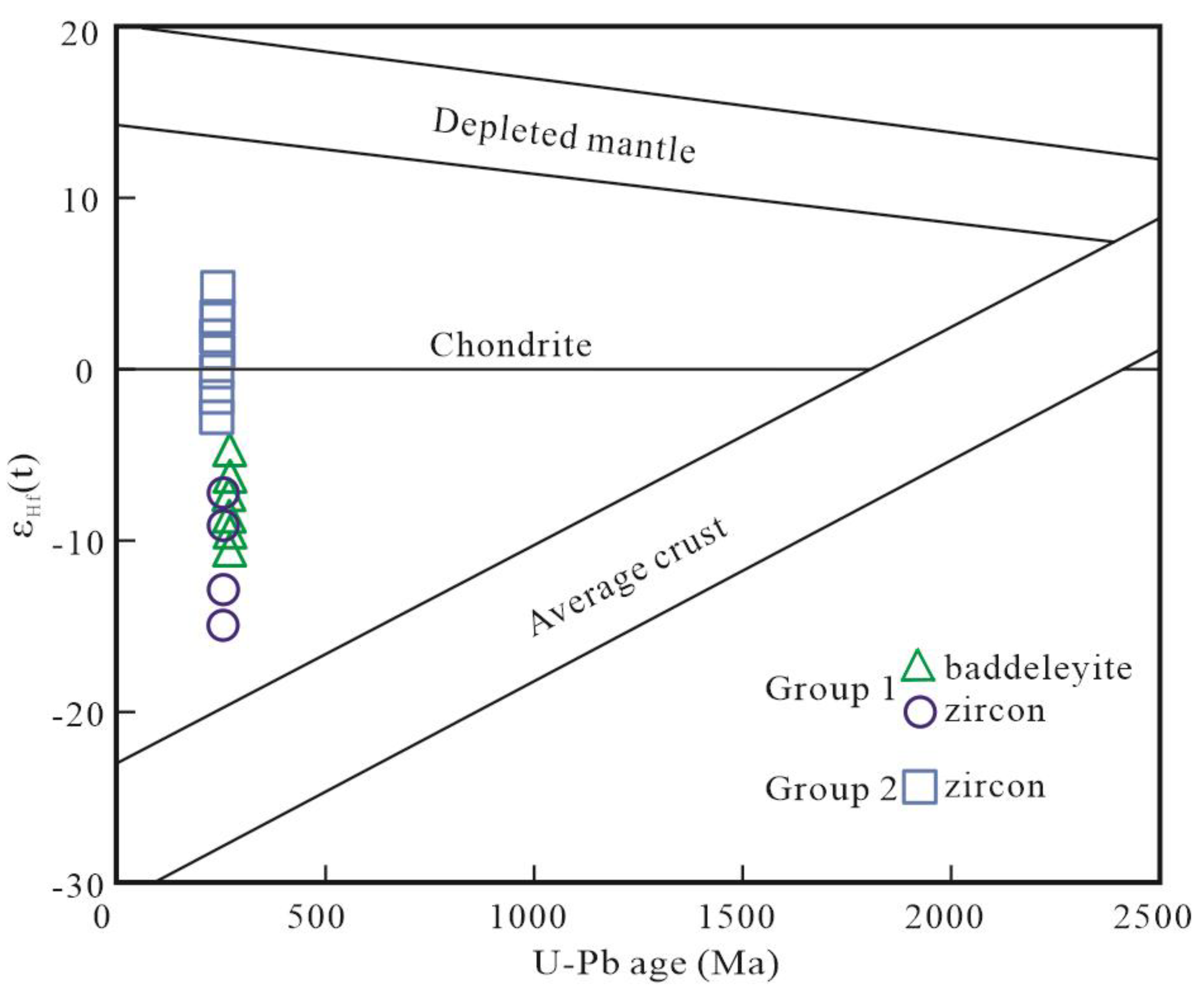
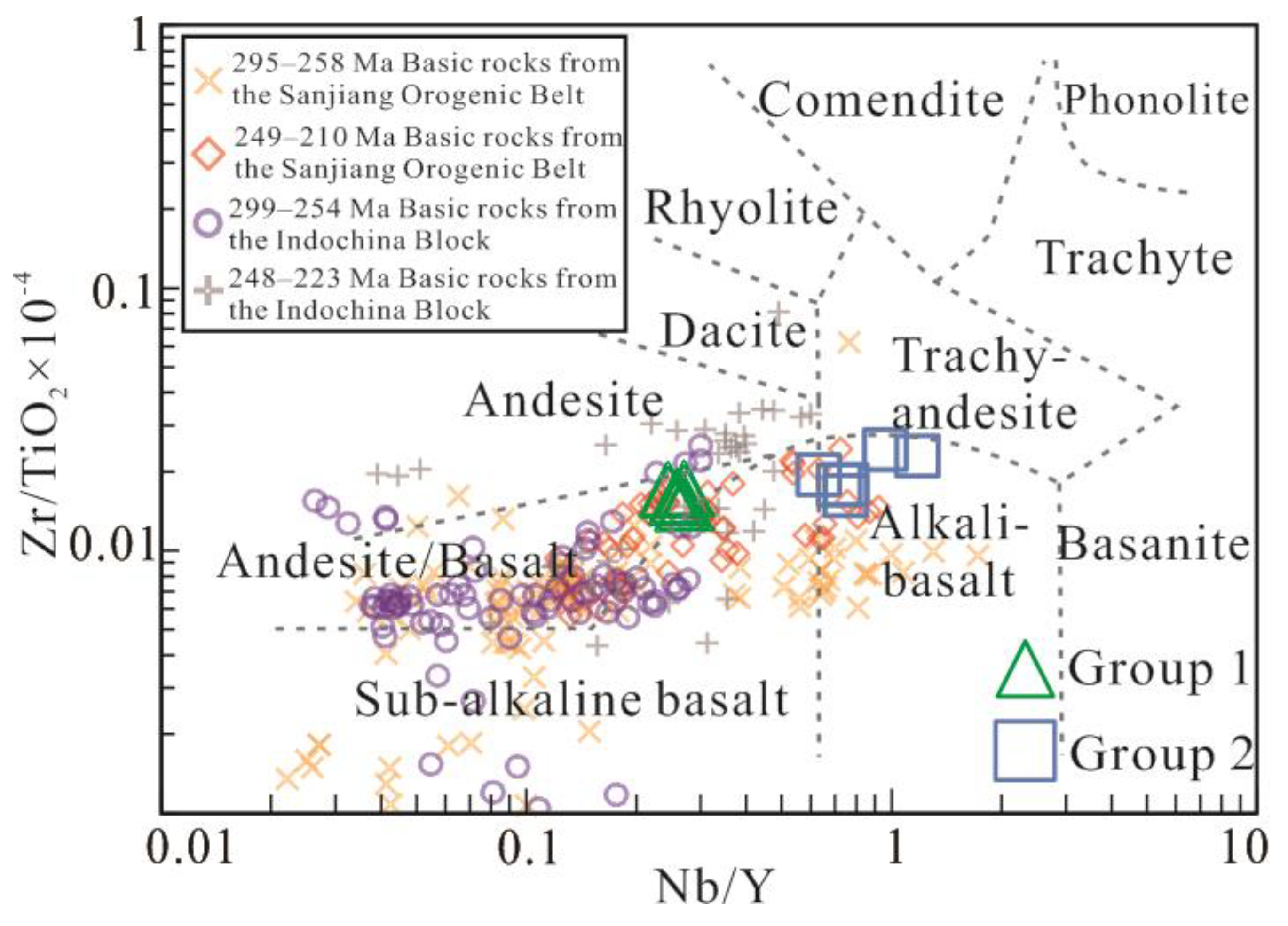
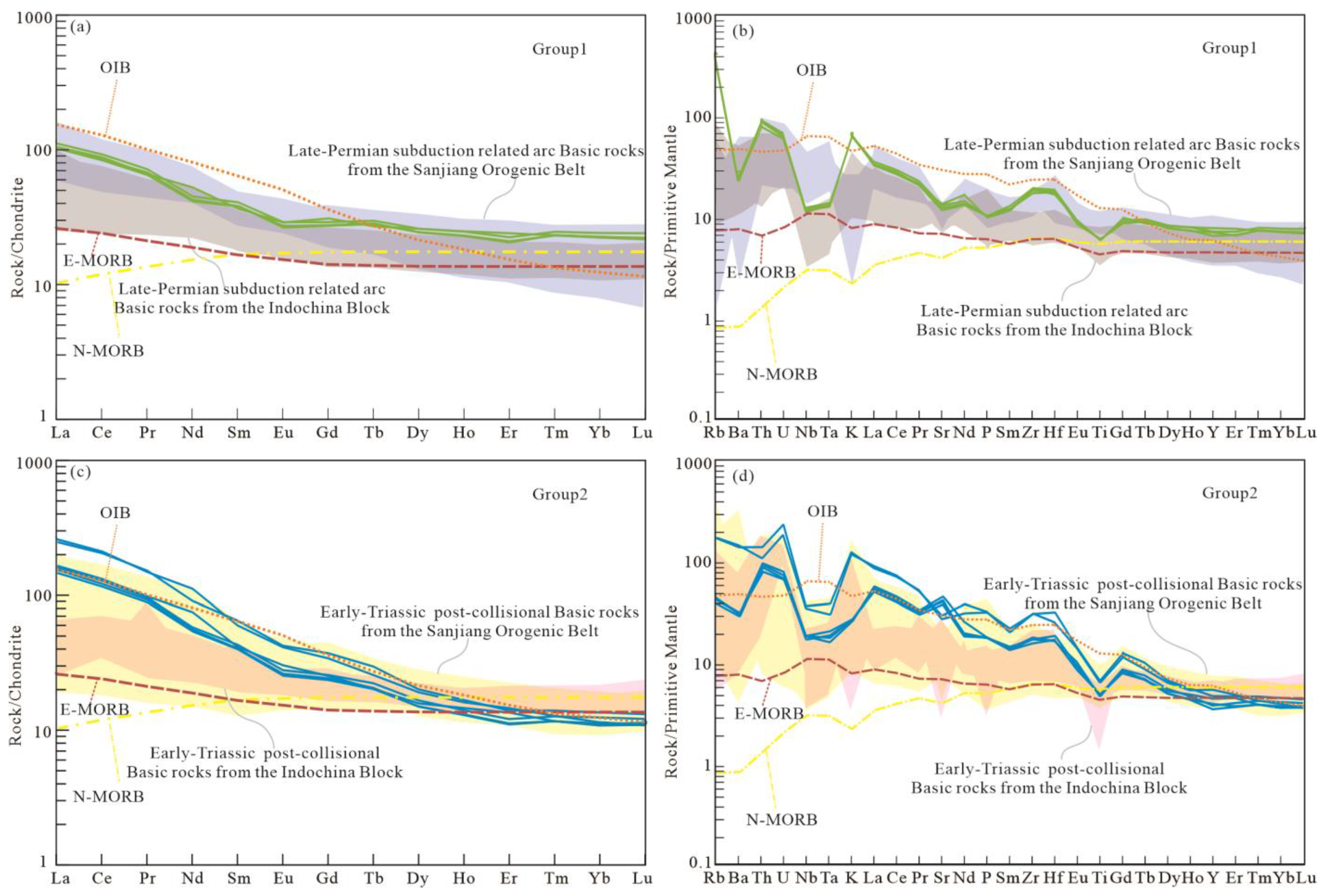

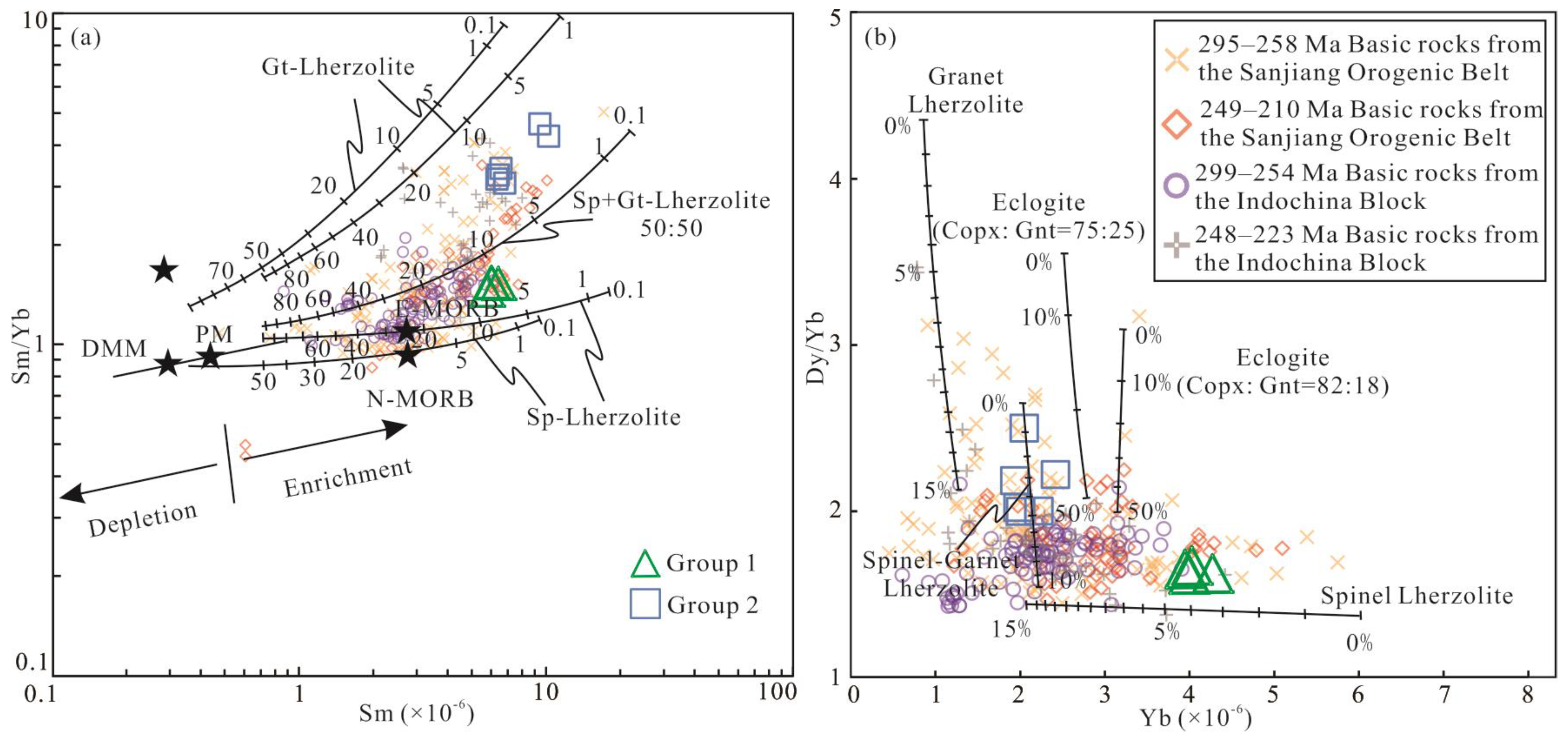

| NO. | Th/U | Isotope Ratio | Age (Ma) | ||||||||||
|---|---|---|---|---|---|---|---|---|---|---|---|---|---|
| 207Pb/206Pb | 1σ | 207Pb/235U | 1σ | 206Pb/238U | 1σ | 207Pb/206Pb | 1σ | 207Pb/235U | 1σ | 206Pb/238U | 1σ | ||
| Sample 16BX34B, baddeleyite | |||||||||||||
| 1 | 3.41 | 0.0512 | 0.0035 | 0.2817 | 0.0182 | 0.0401 | 0.0007 | 250 | 157 | 252 | 14 | 254 | 4 |
| 2 | 1.07 | 0.0513 | 0.0039 | 0.2862 | 0.0209 | 0.0404 | 0.0009 | 257 | 174 | 256 | 16 | 255 | 6 |
| 3 | 6.55 | 0.0508 | 0.0016 | 0.2849 | 0.0094 | 0.0406 | 0.0004 | 235 | 69 | 255 | 7 | 256 | 2 |
| 4 | 13.13 | 0.0520 | 0.0029 | 0.2895 | 0.0158 | 0.0406 | 0.0006 | 287 | 128 | 258 | 12 | 257 | 4 |
| 5 | 10.79 | 0.0515 | 0.0014 | 0.2861 | 0.0078 | 0.0403 | 0.0004 | 265 | 56 | 255 | 6 | 255 | 2 |
| 6 | 8.81 | 0.0515 | 0.0020 | 0.2883 | 0.0133 | 0.0404 | 0.0008 | 265 | 89 | 257 | 10 | 255 | 5 |
| Sample 16BX34B, zircon | |||||||||||||
| 1 | 1.50 | 0.0501 | 0.0030 | 0.2909 | 0.0159 | 0.0406 | 0.0008 | 198 | 139 | 259 | 13 | 257 | 5 |
| 2 | 3.91 | 0.0627 | 0.0025 | 0.1211 | 0.0048 | 0.0141 | 0.0002 | 698 | 88 | 116 | 4 | 90 | 1 |
| 3 | 5.20 | 0.0632 | 0.0051 | 0.1322 | 0.0105 | 0.0147 | 0.0002 | 715 | 138 | 126 | 9 | 94 | 1 |
| 4 | 3.04 | 0.0633 | 0.0084 | 0.1469 | 0.0192 | 0.0168 | 0.0004 | 720 | 290 | 139 | 17 | 107 | 3 |
| 5 | 0.89 | 0.0505 | 0.0009 | 0.2817 | 0.0062 | 0.0403 | 0.0005 | 220 | 36 | 252 | 5 | 255 | 3 |
| 6 | 5.57 | 0.0574 | 0.0044 | 0.1388 | 0.0084 | 0.0154 | 0.0003 | 506 | 203 | 132 | 7 | 98 | 2 |
| 7 | 5.19 | 0.0553 | 0.0060 | 0.1334 | 0.0095 | 0.0151 | 0.0003 | 433 | 242 | 127 | 8 | 97 | 2 |
| 8 | 6.95 | 0.0665 | 0.0080 | 0.1237 | 0.0156 | 0.0137 | 0.0004 | 833 | 254 | 118 | 14 | 88 | 3 |
| 9 | 2.82 | 0.0521 | 0.0013 | 0.2898 | 0.0078 | 0.0401 | 0.0004 | 300 | 56 | 258 | 6 | 254 | 3 |
| 10 | 8.48 | 0.0632 | 0.0077 | 0.1117 | 0.0151 | 0.0128 | 0.0005 | 717 | 259 | 108 | 14 | 82 | 3 |
| 11 | 5.64 | 0.0538 | 0.0014 | 0.4734 | 0.0145 | 0.0634 | 0.0010 | 365 | 59 | 394 | 10 | 396 | 6 |
| 12 | 8.51 | 0.0511 | 0.0022 | 0.2811 | 0.0117 | 0.0405 | 0.0006 | 256 | 98 | 252 | 9 | 256 | 3 |
| 13 | 18.84 | 0.0616 | 0.0098 | 0.1316 | 0.0211 | 0.0154 | 0.0006 | 661 | 344 | 126 | 19 | 99 | 4 |
| 14 | 17.05 | 0.0551 | 0.0057 | 0.1563 | 0.0120 | 0.0171 | 0.0004 | 417 | 233 | 147 | 11 | 109 | 3 |
| 15 | 20.03 | 0.0677 | 0.0078 | 0.1280 | 0.0114 | 0.0141 | 0.0004 | 861 | 243 | 122 | 10 | 91 | 2 |
| 16 | 20.39 | 0.0622 | 0.0123 | 0.1273 | 0.0258 | 0.0146 | 0.0006 | 680 | 432 | 122 | 23 | 94 | 4 |
| 17 | 25.85 | 0.0600 | 0.0050 | 0.3336 | 0.0282 | 0.0405 | 0.0014 | 606 | 181 | 292 | 21 | 256 | 9 |
| 18 | 27.27 | 0.0653 | 0.0030 | 0.1296 | 0.0062 | 0.0144 | 0.0002 | 783 | 95 | 124 | 6 | 92 | 1 |
| 19 | 22.46 | 0.0657 | 0.0038 | 0.1471 | 0.0089 | 0.0159 | 0.0002 | 798 | 92 | 139 | 8 | 102 | 1 |
| 20 | 42.37 | 0.0651 | 0.0031 | 0.1376 | 0.0062 | 0.0149 | 0.0002 | 789 | 100 | 131 | 6 | 95 | 1 |
| 21 | 24.05 | 0.0672 | 0.0079 | 0.1233 | 0.0146 | 0.0135 | 0.0006 | 843 | 241 | 118 | 13 | 86 | 4 |
| 22 | 6.28 | 0.0608 | 0.0023 | 0.5361 | 0.0292 | 0.0633 | 0.0020 | 632 | 86 | 436 | 19 | 395 | 12 |
| Sample 16DF48C, zircon | |||||||||||||
| 1 | 0.82 | 0.0530 | 0.0040 | 0.1360 | 0.0071 | 0.0149 | 0.0003 | 332 | 175 | 129 | 6 | 95 | 2 |
| 2 | 0.85 | 0.0630 | 0.0035 | 0.1076 | 0.0062 | 0.0124 | 0.0003 | 706 | 119 | 104 | 6 | 79 | 2 |
| 3 | 0.03 | 0.0531 | 0.0013 | 0.2804 | 0.0074 | 0.0383 | 0.0004 | 332 | 57 | 251 | 6 | 242 | 3 |
| 4 | 0.90 | 0.0492 | 0.0064 | 0.2015 | 0.0109 | 0.0179 | 0.0005 | 167 | 272 | 186 | 9 | 114 | 3 |
| 5 | 0.16 | 0.0599 | 0.0054 | 0.6966 | 0.0635 | 0.0841 | 0.0021 | 598 | 196 | 537 | 38 | 520 | 13 |
| 6 | 1.14 | 0.0654 | 0.0029 | 0.1126 | 0.0047 | 0.0125 | 0.0002 | 787 | 88 | 108 | 4 | 80 | 1 |
| 7 | 0.87 | 0.0529 | 0.0021 | 0.2800 | 0.0112 | 0.0382 | 0.0004 | 324 | 89 | 251 | 9 | 242 | 3 |
| 8 | 0.20 | 0.0492 | 0.0017 | 0.2561 | 0.0093 | 0.0378 | 0.0006 | 154 | 80 | 231 | 8 | 239 | 3 |
| 9 | 0.02 | 0.0515 | 0.0018 | 0.2695 | 0.0099 | 0.0378 | 0.0004 | 265 | 77 | 242 | 8 | 239 | 3 |
| 10 | 0.02 | 0.0514 | 0.0010 | 0.2713 | 0.0055 | 0.0382 | 0.0004 | 257 | 43 | 244 | 4 | 242 | 2 |
| 11 | 0.09 | 0.0736 | 0.0042 | 0.6267 | 0.0382 | 0.0614 | 0.0010 | 1031 | 110 | 494 | 24 | 384 | 11 |
| 12 | 0.27 | 0.0494 | 0.0039 | 0.2546 | 0.0174 | 0.0378 | 0.0009 | 165 | 174 | 230 | 14 | 239 | 5 |
| 13 | 0.09 | 0.0520 | 0.0009 | 0.2749 | 0.0055 | 0.0383 | 0.0004 | 283 | 41 | 247 | 4 | 242 | 2 |
| 14 | 0.03 | 0.0728 | 0.0042 | 0.3834 | 0.0217 | 0.0381 | 0.0008 | 1009 | 117 | 330 | 16 | 241 | 14 |
| 15 | 0.81 | 0.0519 | 0.0012 | 0.2712 | 0.0075 | 0.0378 | 0.0006 | 280 | 52 | 244 | 6 | 239 | 4 |
| 16 | 0.12 | 0.0526 | 0.0014 | 0.2743 | 0.0075 | 0.0378 | 0.0004 | 309 | 59 | 246 | 6 | 239 | 2 |
| 17 | 0.17 | 0.0856 | 0.0017 | 2.5732 | 0.0566 | 0.2173 | 0.0024 | 1329 | 34 | 1293 | 16 | 1268 | 17 |
| 18 | 0.36 | 0.0507 | 0.0013 | 0.2664 | 0.0066 | 0.0380 | 0.0004 | 228 | 57 | 240 | 5 | 240 | 2 |
| 19 | 0.55 | 0.0931 | 0.0021 | 3.2022 | 0.0720 | 0.2489 | 0.0027 | 1500 | 42 | 1458 | 17 | 1433 | 14 |
| 20 | 0.19 | 0.0937 | 0.0040 | 3.4848 | 0.1380 | 0.2704 | 0.0067 | 1502 | 82 | 1524 | 31 | 1543 | 34 |
| Sample 16DF48D, zircon | |||||||||||||
| 1 | 1.98 | 0.0543 | 0.0058 | 0.4464 | 0.0258 | 0.0379 | 0.0011 | 383 | 244 | 375 | 18 | 240 | 7 |
| 2 | 1.49 | 0.0522 | 0.0092 | 0.4051 | 0.0370 | 0.0383 | 0.0013 | 295 | 359 | 345 | 27 | 243 | 8 |
| 3 | 1.59 | 0.0477 | 0.0066 | 0.3166 | 0.0303 | 0.0376 | 0.0012 | 87 | 313 | 279 | 23 | 238 | 8 |
| 4 | 0.20 | 0.0488 | 0.0044 | 0.2497 | 0.0214 | 0.0376 | 0.0010 | 139 | 200 | 226 | 17 | 238 | 6 |
| 5 | 1.76 | 0.0489 | 0.0068 | 0.4024 | 0.0265 | 0.0379 | 0.0013 | 143 | 296 | 343 | 19 | 240 | 8 |
| 6 | 0.42 | 0.0556 | 0.0027 | 0.2873 | 0.0141 | 0.0379 | 0.0008 | 435 | 106 | 256 | 11 | 240 | 5 |
| 7 | 0.29 | 0.0551 | 0.0018 | 0.4574 | 0.0150 | 0.0608 | 0.0006 | 417 | 74 | 382 | 10 | 381 | 4 |
| 8 | 2.02 | 0.0543 | 0.0101 | 0.3690 | 0.0408 | 0.0384 | 0.0023 | 383 | 370 | 319 | 30 | 243 | 14 |
| 9 | 0.29 | 0.0487 | 0.0046 | 0.1882 | 0.0116 | 0.0172 | 0.0004 | 200 | 139 | 175 | 10 | 110 | 3 |
| 10 | 1.04 | 0.0547 | 0.0043 | 0.3616 | 0.0177 | 0.0382 | 0.0007 | 467 | 176 | 313 | 13 | 242 | 4 |
| 11 | 1.34 | 0.0573 | 0.0119 | 0.3790 | 0.0371 | 0.0388 | 0.0016 | 506 | 400 | 326 | 27 | 245 | 10 |
| 12 | 1.78 | 0.0513 | 0.0206 | 0.3710 | 0.0805 | 0.0377 | 0.0022 | 257 | 726 | 320 | 60 | 239 | 14 |
| 13 | 0.25 | 0.0537 | 0.0021 | 0.4469 | 0.0205 | 0.0602 | 0.0012 | 367 | 95 | 375 | 14 | 377 | 7 |
| 14 | 1.27 | 0.0564 | 0.0042 | 0.3925 | 0.0188 | 0.0381 | 0.0007 | 478 | 164 | 336 | 14 | 241 | 4 |
| 15 | 1.23 | 0.0523 | 0.0091 | 0.3364 | 0.0390 | 0.0385 | 0.0015 | 298 | 356 | 294 | 30 | 244 | 9 |
| 16 | 1.29 | 0.0473 | 0.0042 | 0.3502 | 0.0190 | 0.0377 | 0.0008 | 65 | 200 | 305 | 14 | 239 | 5 |
| 17 | 0.84 | 0.0545 | 0.0059 | 0.1307 | 0.0109 | 0.0159 | 0.0004 | 394 | 243 | 125 | 10 | 102 | 3 |
| 18 | 1.33 | 0.0931 | 0.0296 | 0.3781 | 0.0739 | 0.0361 | 0.0038 | 1500 | 637 | 326 | 54 | 228 | 23 |
| No. | 176Hf/177Hf | 2σ | 176Lu/177Hf | 2σ | 176Yb/177Hf | 2σ | Age/Ma | εHf(t) | 2σ | TDM2/Ma |
|---|---|---|---|---|---|---|---|---|---|---|
| Sample 16BX34B, baddeleyite | ||||||||||
| 1 | 0.282575 | 0.000020 | 0.035205 | 0.001083 | 0.001151 | 0.299921 | 254 | −7.32 | 0.71 | 1420 |
| 2 | 0.282425 | 0.000019 | 0.023103 | 0.000796 | 0.001289 | 0.458691 | 255 | −10.56 | 0.67 | 1579 |
| 3 | 0.282486 | 0.000024 | 0.029539 | 0.001022 | 0.001062 | 0.293931 | 256 | −9.49 | 0.84 | 1527 |
| 4 | 0.282547 | 0.000024 | 0.022946 | 0.000760 | 0.000877 | 0.325695 | 257 | −6.25 | 0.83 | 1367 |
| 5 | 0.282580 | 0.000025 | 0.043853 | 0.001545 | 0.001499 | 0.274112 | 255 | −8.57 | 0.87 | 1482 |
| 6 | 0.282508 | 0.000025 | 0.005814 | 0.000239 | 0.000256 | 0.302946 | 255 | −4.70 | 0.87 | 1291 |
| Sample 16BX34B, zircon | ||||||||||
| 1 | 0.282525 | 0.000025 | 0.022620 | 0.000714 | 0.000703 | 0.276865 | 257 | −6.95 | 0.87 | 1402 |
| 5 | 0.282432 | 0.000025 | 0.038154 | 0.001304 | 0.001527 | 0.331220 | 255 | −12.85 | 0.86 | 1692 |
| 6 | 0.282606 | 0.000024 | 0.015710 | 0.000550 | 0.000531 | 0.273169 | 98 | −2.91 | 0.85 | 1202 |
| 9 | 0.282443 | 0.000021 | 0.052749 | 0.001865 | 0.002204 | 0.333836 | 254 | −14.94 | 0.74 | 1794 |
| 10 | 0.282632 | 0.000022 | 0.022198 | 0.000921 | 0.001133 | 0.347385 | 82 | −3.09 | 0.76 | 1211 |
| 12 | 0.282443 | 0.000022 | 0.016649 | 0.000574 | 0.000624 | 0.307513 | 256 | −8.85 | 0.76 | 1495 |
| 13 | 0.282674 | 0.000027 | 0.025916 | 0.000842 | 0.000834 | 0.279887 | 99 | −2.23 | 0.93 | 1169 |
| 16 | 0.282598 | 0.000025 | 0.026890 | 0.000955 | 0.000878 | 0.258730 | 94 | −5.10 | 0.89 | 1310 |
| Sample 16DF48C, zircon | ||||||||||
| 1 | 0.282635 | 0.000036 | 0.001830 | 0.000079 | 0.060482 | 0.002213 | 95 | 0.12 | 1.27 | 1040 |
| 2 | 0.282633 | 0.000029 | 0.001537 | 0.000009 | 0.053666 | 0.000268 | 79 | 0.12 | 1.03 | 1040 |
| 3 | 0.282653 | 0.000028 | 0.000528 | 0.000007 | 0.019168 | 0.000279 | 242 | 0.99 | 0.98 | 997 |
| 8 | 0.282546 | 0.000028 | 0.000619 | 0.000013 | 0.021246 | 0.000363 | 239 | −2.82 | 0.97 | 1186 |
| 9 | 0.282685 | 0.000028 | 0.001785 | 0.000062 | 0.044342 | 0.001863 | 239 | 1.92 | 0.97 | 950 |
| 10 | 0.282716 | 0.000026 | 0.001748 | 0.000008 | 0.051723 | 0.000243 | 242 | 3.00 | 0.92 | 896 |
| 13 | 0.282768 | 0.000020 | 0.002392 | 0.000065 | 0.055243 | 0.001746 | 242 | 4.74 | 0.70 | 810 |
| 15 | 0.282588 | 0.000043 | 0.002559 | 0.000020 | 0.056763 | 0.000656 | 239 | −1.63 | 1.50 | 1126 |
| 16 | 0.282620 | 0.000034 | 0.000337 | 0.000033 | 0.011051 | 0.000932 | 239 | −0.16 | 1.21 | 1054 |
| 17 | 0.282121 | 0.000022 | 0.001179 | 0.000062 | 0.029418 | 0.001299 | 1329 | −17.96 | 0.77 | 1929 |
| 18 | 0.282716 | 0.000042 | 0.001719 | 0.000069 | 0.042785 | 0.002074 | 240 | 3.02 | 1.48 | 896 |
| Sample | Group1 | Group2 | ||||||||
|---|---|---|---|---|---|---|---|---|---|---|
| 16BX34B | 16BX34B1 | 16BX34B2 | 16BX34B3 | 16DF48C | 16DF48C1 | 16DF48C2 | 16DF48C3 | 16DF48D | 16DF48D1 | |
| SiO2 | 51.05 | 50.81 | 50.97 | 50.50 | 52.48 | 52.73 | 52.84 | 52.73 | 55.49 | 55.31 |
| TiO2 | 1.43 | 1.47 | 1.47 | 1.44 | 1.04 | 1.10 | 1.10 | 1.10 | 1.44 | 1.52 |
| Al2O3 | 16.14 | 15.96 | 16.02 | 15.87 | 15.60 | 15.60 | 15.66 | 15.67 | 15.77 | 15.71 |
| Fe2O3T | 11.47 | 11.73 | 11.69 | 11.73 | 8.01 | 8.43 | 8.45 | 8.45 | 6.84 | 7.10 |
| MgO | 5.72 | 5.77 | 5.77 | 5.77 | 5.19 | 5.26 | 5.27 | 5.24 | 3.46 | 3.60 |
| CaO | 7.76 | 7.83 | 7.87 | 7.90 | 7.37 | 7.54 | 7.53 | 7.53 | 4.27 | 4.31 |
| K2O | 2.14 | 2.23 | 2.23 | 2.18 | 0.78 | 0.82 | 0.82 | 0.82 | 3.51 | 3.68 |
| Na2O | 2.80 | 2.73 | 2.78 | 2.71 | 3.49 | 3.33 | 3.36 | 3.38 | 4.20 | 4.01 |
| MnO | 0.20 | 0.20 | 0.20 | 0.20 | 0.11 | 0.12 | 0.12 | 0.12 | 0.10 | 0.11 |
| P2O5 | 0.24 | 0.25 | 0.25 | 0.25 | 0.39 | 0.39 | 0.39 | 0.39 | 0.70 | 0.69 |
| LOI | 0.94 | 0.77 | 0.8 | 0.71 | 4.38 | 4. 47 | 4.48 | 4.58 | 3.33 | 3.41 |
| Total | 99.89 | 99.76 | 100.05 | 99.26 | 98.84 | 99.78 | 100.02 | 100.02 | 99.11 | 99.46 |
| Mg# | 54 | 53 | 54 | 53 | 60 | 59 | 59 | 59 | 54 | 54 |
| V | 214 | 179 | 192 | 203 | 163 | 126 | 138 | 142 | 135 | 114 |
| Cr | 40.0 | 43.7 | 44.8 | 48.5 | 150 | 145 | 157 | 160 | 60 | 78.1 |
| Ga | 22.3 | 3.43 | 3.74 | 3.85 | 20.8 | 3.36 | 3.65 | 3.77 | 19 | 13.5 |
| Rb | 267 | 260 | 278 | 291 | 28.5 | 25.7 | 27.8 | 29.1 | 113 | 111 |
| Sr | 321 | 278 | 295 | 312 | 997 | 833 | 888 | 919 | 657 | 604 |
| Y | 39.7 | 33.2 | 36.1 | 36.8 | 21.8 | 17.2 | 18.7 | 19.4 | 26.6 | 23.1 |
| Zr | 241 | 217 | 232 | 244 | 212 | 186 | 203 | 203 | 360 | 359 |
| Nb | 9.7 | 8.97 | 9.37 | 9.95 | 13.8 | 12.9 | 14.1 | 13.9 | 25.7 | 27.3 |
| Cs | 52.6 | 51.5 | 54 | 56.6 | 1.02 | 0.98 | 1.06 | 1.06 | 2.1 | 2.18 |
| Ba | 186 | 180 | 197 | 204 | 232 | 214 | 231 | 223 | 1040 | 999 |
| La | 25.7 | 25.1 | 25.6 | 27.3 | 40.8 | 36.1 | 39.7 | 38.1 | 64.1 | 61.1 |
| Ce | 55.6 | 52.9 | 53.8 | 58.4 | 83.9 | 73.7 | 81.4 | 77.3 | 134 | 130 |
| Pr | 6.48 | 6.39 | 6.67 | 7.04 | 9.68 | 8.74 | 9.48 | 9.14 | 14.7 | 15 |
| Nd | 25.4 | 20.1 | 20.6 | 21.8 | 36.4 | 26.3 | 28.1 | 27.1 | 54.2 | 44 |
| Sm | 5.81 | 6.04 | 6.08 | 6.47 | 6.6 | 6.35 | 6.84 | 6.43 | 9.51 | 10.3 |
| Eu | 1.74 | 1.6 | 1.64 | 1.75 | 1.83 | 1.54 | 1.68 | 1.58 | 2.49 | 2.56 |
| Gd | 6.6 | 5.83 | 5.89 | 6.21 | 5.42 | 5.04 | 5.49 | 5.2 | 7.3 | 7.97 |
| Tb | 1.05 | 1.09 | 1.1 | 1.15 | 0.79 | 0.79 | 0.87 | 0.8 | 1 | 1.16 |
| Dy | 6.77 | 6.46 | 6.43 | 6.85 | 4.18 | 3.96 | 4.4 | 3.95 | 5.06 | 5.31 |
| Ho | 1.46 | 1.36 | 1.34 | 1.45 | 0.86 | 0.76 | 0.83 | 0.77 | 0.95 | 0.99 |
| Er | 4.13 | 3.61 | 3.54 | 3.86 | 2.33 | 1.91 | 2.08 | 1.94 | 2.51 | 2.42 |
| Tm | 0.61 | 0.61 | 0.62 | 0.65 | 0.31 | 0.31 | 0.34 | 0.31 | 0.34 | 0.37 |
| Yb | 4.01 | 3.94 | 3.98 | 4.26 | 1.92 | 1.99 | 2.2 | 1.96 | 2.03 | 2.4 |
| Lu | 0.58 | 0.57 | 0.59 | 0.63 | 0.29 | 0.29 | 0.32 | 0.3 | 0.29 | 0.35 |
| Hf | 5.8 | 6.13 | 6.21 | 6.47 | 5.4 | 5.55 | 6.06 | 5.42 | 8.2 | 10.3 |
| Ta | 0.6 | 0.61 | 0.58 | 0.64 | 0.7 | 0.81 | 0.89 | 0.77 | 1.3 | 1.65 |
| Th | 7.54 | 8.65 | 8.45 | 8.72 | 6.89 | 7.98 | 8.54 | 7.56 | 9.54 | 12.2 |
| U | 1.4 | 1.5 | 1.47 | 1.58 | 1.45 | 1.59 | 1.72 | 1.48 | 3.87 | 5.04 |
| W | 4 | 3.39 | 3.11 | 3.65 | 1 | 0.5 | 0.58 | 0.49 | 1 | 0.89 |
| ∑HREE | 25.2 | 23.5 | 23.5 | 25.1 | 16.1 | 15.1 | 16.5 | 15.2 | 19.5 | 21 |
| ∑LREE | 121 | 112 | 114 | 123 | 179 | 153 | 167 | 160 | 279 | 263 |
| ∑REE | 146 | 136 | 138 | 148 | 195 | 168 | 184 | 175 | 298 | 284 |
| δEu | 0.86 | 0.81 | 0.83 | 0.83 | 0.91 | 0.8 | 0.81 | 0.81 | 0.88 | 0.83 |
Disclaimer/Publisher’s Note: The statements, opinions and data contained in all publications are solely those of the individual author(s) and contributor(s) and not of MDPI and/or the editor(s). MDPI and/or the editor(s) disclaim responsibility for any injury to people or property resulting from any ideas, methods, instructions or products referred to in the content. |
© 2025 by the authors. Licensee MDPI, Basel, Switzerland. This article is an open access article distributed under the terms and conditions of the Creative Commons Attribution (CC BY) license (https://creativecommons.org/licenses/by/4.0/).
Share and Cite
Ouyang, J.; Chen, G.; Yang, L.; Lu, W.; Zhou, Y. Tectonic Evolution of the Hainan Island, South China: Geochronological and Geochemical Constraints from Late Permian to Early Triassic Basalts. Minerals 2025, 15, 293. https://doi.org/10.3390/min15030293
Ouyang J, Chen G, Yang L, Lu W, Zhou Y. Tectonic Evolution of the Hainan Island, South China: Geochronological and Geochemical Constraints from Late Permian to Early Triassic Basalts. Minerals. 2025; 15(3):293. https://doi.org/10.3390/min15030293
Chicago/Turabian StyleOuyang, Jieting, Guoyu Chen, Liya Yang, Wenqian Lu, and Yun Zhou. 2025. "Tectonic Evolution of the Hainan Island, South China: Geochronological and Geochemical Constraints from Late Permian to Early Triassic Basalts" Minerals 15, no. 3: 293. https://doi.org/10.3390/min15030293
APA StyleOuyang, J., Chen, G., Yang, L., Lu, W., & Zhou, Y. (2025). Tectonic Evolution of the Hainan Island, South China: Geochronological and Geochemical Constraints from Late Permian to Early Triassic Basalts. Minerals, 15(3), 293. https://doi.org/10.3390/min15030293








